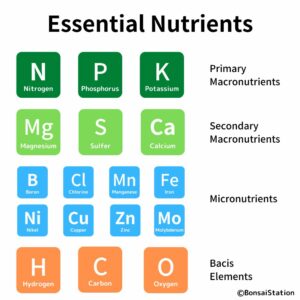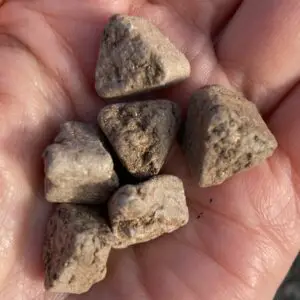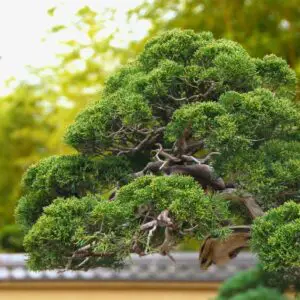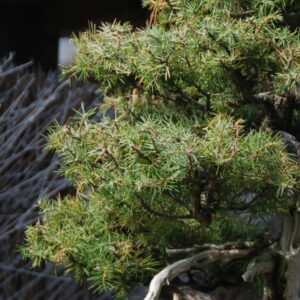Juniper bonsai need fertilizers to grow healthy with beautiful green needles. For its optimal growth, it’s recommended to use a slow-release solid fertilizer with an NPK ratio of 2-1-1. This fertilizer should be applied every 4 to 6 weeks during the growing season, excluding hot summer days.
Basics of juniper bonsai fertilization
Nutrient Needs of Juniper Bonsai
Essential nutrients

Juniper bonsai, like all plants, require nutrients to grow and thrive. There are 17 essential nutrients that all plants need to grow. These nutrients are grouped into four categories based on the relative quantity of each nutrient plants need and where plants obtain from:
-
- primary macronutrients
- secondary macronutrients
- micronutrients, and
- basic elements.
All of these nutrients are equally important but primary macronutrients are needed in larger amounts and play a key role in juniper bonsai trees’ growth. There are three primary macronutrients as follows:
-
- Nitrogen (N)
- Phosphorus (P)
- Potassium (K)
Nitrogen is essential for growth and foliage development, while phosphorus aids in root development. Potassium is crucial for overall tree health and helps with stress tolerance and disease resistance.
Understanding the nutrient needs of your juniper bonsai is the first step in determining what type of fertilizer to use and how often to apply it. By providing your juniper bonsai with the right nutrients in the correct amounts, you can ensure that it remains healthy and vibrant for years to come.
Nutrient needs of juniper bonsai
Although wild junipers tend to grow in lower-nutrient environments such as rocky terrain and poor soils, juniper bonsai cannot grow healthy with beautiful green needles in poor nutrient soil when planted in a small bonsai pot.
Juniper bonsai need nutrients that support leaves to make energy and grow strong. As such, the recommended NPK ratio for juniper bonsai trees is 2-1-1, emphasizing the nitrogen ratio for leaf growth.
Please be cautious that too much nitrogen can cause juniper bonsai trees to develop excessive foliage growth or elongated branches, which can deform their overall style. This is why it is important to use a more or less balanced fertilizer with a bit higher nitrogen ratio for juniper bonsai.
Types of Fertilizers for Juniper Bonsai

BioGold Bonsai fertilizer
There are several different types of fertilizer available for juniper bonsai, which can be categorized based on their origin (organic/inorganic), release rate (fast/slow), and form (solid/liquid).
Among those, choosing slow-release fertilizers is crucial for juniper bonsai, or any other bonsai trees. Both inorganic and organic fertilizers can be used as long as they are slow-release, and solid fertilizers are better than the liquid form for juniper bonsai trees.
Liquid fertilizers are fast-acting, which is good sometimes, but their nutrients can be easily washed out with frequent watering and the risk of over-fertilization is higher. This is why I do not recommend using liquid fertilizers as a main source of nutrient supplements for bonsai trees.
Personally, inorganic fertilizers are easy to handle because they are odorless, insectless (worms like organic matter) and last longer (do not go bad). This is only my personal preference and organic fertilizers work just fine.
In short, for juniper bonsai trees I would recommend fertilizers that are;
- Solid,
- Slow-release, and
- Inorganic (/organic).
If you are interested in knowing why this type of fertilizer is good for bonsai trees, the following post might be helpful.
How to fertilize juniper bonsai
Fertilizer application methods for juniper bonsai

Shimpaku juniper
There are the following 2 ways to apply fertilizers to juniper bonsai trees:
-
- Top dressing solid fertilizers to the surface of the soil, and
- Applying a liquid fertilizer (if and when necessary).
Using slow-release solid fertilizers aims to provide a steady supply of nutrients to the trees throughout the growing season. Liquid fertilizers, on the other hand, provide a quick boost of nutrients to the trees, to supplement the nutrients needed and help support healthy growth and development.
Incorporating organic matter in the soil is not usually recommended for juniper bonsai trees because they grow in a low-nutrient environment naturally and need well-drained soil (organic matter makes the soil wet).
A step-by-step guide to applying fertilizers for juniper bonsai

Shimpaku juniper
Step 1: Choose appropriate fertilizers
Select a slow-release fertilizer with an NPK ratio of 2-1-1. Both inorganic and organic options can work well, but if you were to choose an inorganic one, be sure to choose the one labeled “slow-release” or “controlled-release”.
Product recommendations
Leaves and Soul Bonsai Fertilizer Pellets
- Solid: My pick for the best solid fertilizer for juniper bonsai trees is Bonsai Fertilizer Pellets by Leaves and Soul. This is a slow-release fertilizer in pellet form that is specifically formulated for bonsai trees.
Dyna-Gro Bonsai-Pro Liquid Fertilizer
- Liquid: My pick for the best liquid fertilizer for juniper bonsai trees is Dyna-Gro Bonsai-Pro Liquid Fertilizer. It is a concentrated liquid fertilizer that is also specifically formulated for bonsai trees.
- Organic: My pick for the best organic fertilizer for juniper bonsai trees is BioGold Bonsai Fertilizer. It is an organic fertilizer made from chicken manure through a Japanese traditional fertilization method.
These products have slightly different NPK ratios but they should work just fine for juniper bonsai trees.
For more detailed information on why these products are my favorites and why you should consider them, please read the following post.
Step 2: Schedule fertilization for the year
It is recommended to fertilize juniper bonsai trees in spring and fall, which are the active growing season and the storing of energy season.
Apply a slow-release solid fertilizer from the beginning of spring between 4 to 6 weeks apart (except during hot summer). Then, throughout the growing season, you can apply a liquid fertilizer once or twice a month if necessary.
Note that the frequency of fertilization varies depending on the age and species of the tree and the type of fertilizer used. Always follow the manufacturer’s instructions for application rates and frequency.
Avoid fertilizing in hot summer and winter. Summer is a stressful season for any bonsai trees and giving nutrients can do more harm than good. In winter, your juniper bonsai is in a quasi-dormant state and do not require as many nutrients as in the growing season.
Step 3: Apply solid fertilizer
After measuring the appropriate amount of fertilizer according to the label, scatter/place the fertilizer towards the rim of the pot, avoiding the surface root area.
You may need to use a small hand rake or chopstick to incorporate the fertilizer into the top layer of soil if it is instructed on the label. Then, water your trees thoroughly to help the fertilizer penetrate the soil.
It is important to monitor the nutrient levels of the soil regularly by observing your trees and make adjustments to the amount of fertilizer used as necessary.
Step 4: Apply liquid fertilizer
Applying liquid fertilizer in addition to solid fertilizer is an extra step only necessary when solid fertilizer is not giving enough nutrients.
Mix the liquid fertilizer with water according to the instructions. The ratio will vary depending on the type of fertilizer and the stage of growth of your trees but make it twice the labeled dilution to avoid overfertilization.
Make sure to water before and after the application to help the fertilizer distribute evenly in the soil.
Over- or under-fertilizing juniper bonsai

Needle juniper
Because of the unique growing condition, controlling the amount of fertilizers for bonsai trees is one of the challenges you may face with fertilizing bonsai trees. You may over- or under-fertilize your juniper bonsai quite easily.
Here are some signs to look out for that may indicate that your juniper bonsai is being over- or under-fertilized. Many of the symptoms of leaf color change and growth deformities can be indicative of both over-fertilization and under-fertilization.
- Leaf yellowing
- leaf browning/bronzing leaf tips and margins
- Leaf falling off
- Very slow or no growth
- Wilting
If you notice any of these signs, it is important to adjust fertilizing your juniper bonsai immediately.
Note that these symptoms can be caused by other factors such as excess/shortage of water, not enough sunlight, an infestation of some kind or a sudden change of environment. It is thus important to observe your tree and assess the cause before trying to fix the problem.
If you want to know how to tell if the problem of your bonsai tree is from under- or over-fertilization and how to fix it, the following post might be helpful.



